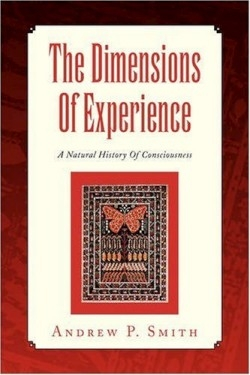The Dimensions of Experience
A Natural History of Consciousness
Throughout the history of mankind, mystics and seers have claimed the existence of a universal power or consciousness that unites us all. Albert Einstein tried unsuccessfully, in the last years of his life, to prove a unified field theory of the universe. While scientists depend upon rigorous methods of proof to develop their hunches, mystics search their inner consciousness for greater understanding of the mysteries of life.
The Dimensions of Experience: A Natural History of Consciousness presents the ideas of Andrew P. Smith, a longtime practitioner of meditation and a trained neuroscientist. He endeavors to link his knowledge of science with the intimations of universal consciousness he has perceived through meditation. His exploration, reflective of the ancient concept of panpsychism, supposes that all forms of life experience consciousness. Instead of comparing the level of awareness of different organisms in an effort to quantify consciousness, he considers different levels of existence, noting similar ratios of atoms in cells, to cells in an organism, to organisms on earth.
Andrew P. Smith earned a doctorate in neurosciences from Stanford University. He has conducted research in molecular biology, pharmacology, cancer, and neuroscience. Now associated with the California Pacific Medical Center Research Institute in San Francisco, Smith’s published work includes book chapters and scientific articles.
Consciousness can be conceived to exist from the lowest invertebrate and vertebrate forms, up through human consciousness and far beyond. “Consider that our human awareness, which most people take as the pinnacle of consciousness, may be but itself a vanishingly tiny fraction of the degree of consciousness possible,” Smith writes.
Evidence that higher vertebrates express emotional feelings through functional emotional behavior serves to demonstrate the experience of consciousness. The author writes, “The fact that vertebrates such as birds and mammals have similar limbic structures to ours, and undergo somewhat similar forms of physiological arousal, is strong evidence…that they feel emotions as we do.”
Group selection evidenced in metabolic and neuronal networks, as well as human societies, enable individual members to survive and develop. Selection is determined by properties of the group rather than the qualities of individuals. Each entity seeks a group that best suits its needs. These networks are highly resistant to disruption, and selective removal of one individual has little effect on the others. “Small world networks help create a brain that is more efficient in terms of not simply information processing, but also energy use,” Smith writes.
The author writes in a lucid style that makes the book accessible to nonscientists, and his wry humor brings alive the scientific detail he describes. Unfortunately, typographical errors, such as words placed out of context, mar this otherwise professional work.
Neither all scientists nor every spiritual seeker will agree with the premises presented in this book. However, it offers people of both disciplines, as well as lay readers, some challenging ideas to consider as they contemplate a possible connection between the material and spiritual worlds.
Disclosure: This article is not an endorsement, but a review. The publisher of this book provided free copies of the book and paid a small fee to have their book reviewed by a professional reviewer. Foreword Reviews and Clarion Reviews make no guarantee that the publisher will receive a positive review. Foreword Magazine, Inc. is disclosing this in accordance with the Federal Trade Commission’s 16 CFR, Part 255.


